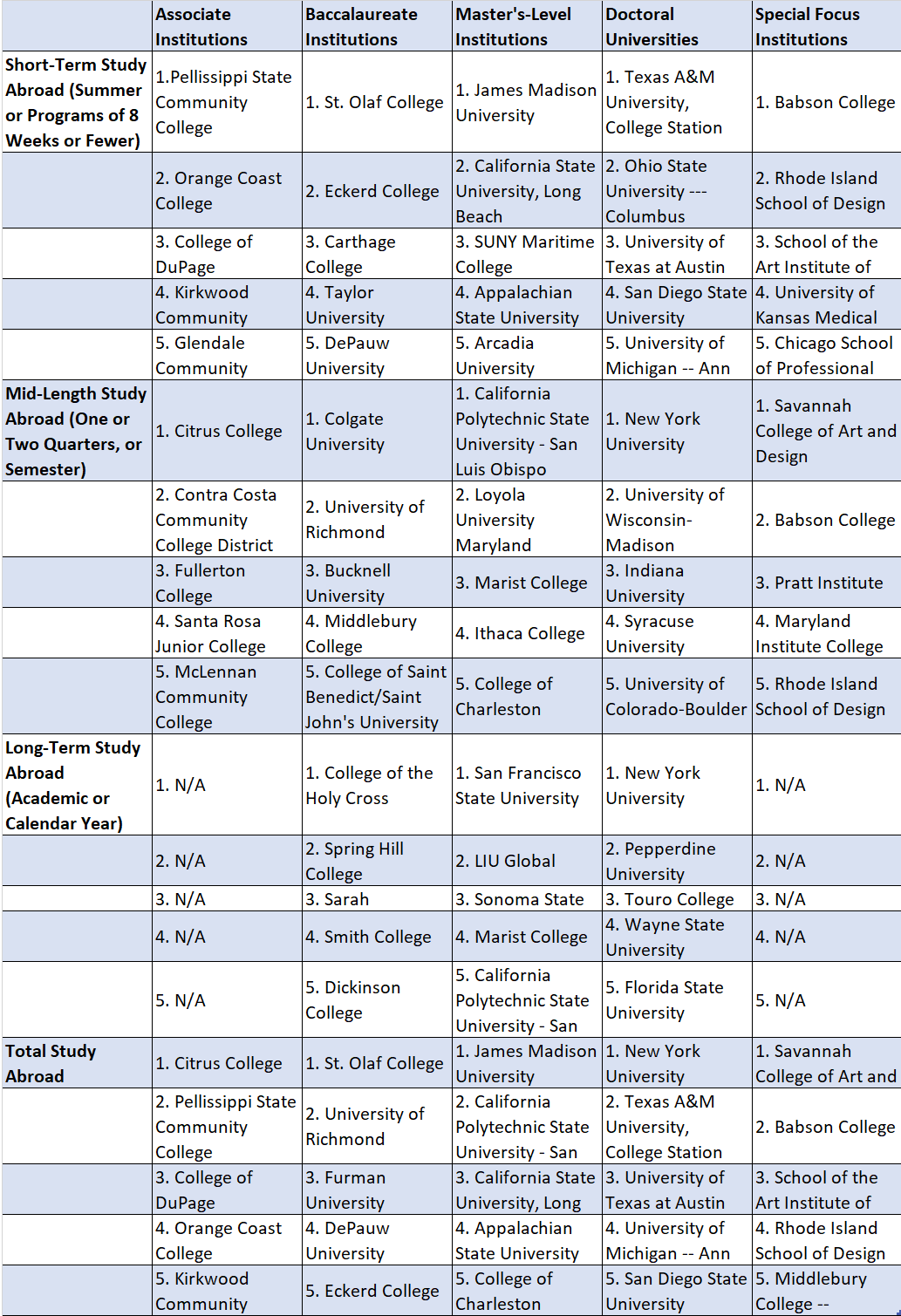You have /5 articles left.
Sign up for a free account or log in.

Institute of International Education
A total of 341,751 students studied abroad for credit in 2017-18, representing a 2.7 percent increase from the previous academic year, according to the annual "Open Doors" report, published by the Institute of International Education with funding from the U.S. Department of State.
The number of students studying abroad has grown steadily over the last 25 years. IIE estimates that about 10.9 percent of all undergraduates (including community college students), and 16 percent of all students enrolled in baccalaureate programs, study abroad at some point during their degree program.
Dip in Enrolled International Students
The number of undergraduate, graduate
and nondegree students fell by
1.3 percent in 2018-19, while those
in optional practical training grew. Read
more here.
The profile of students studying abroad has also grown more racially diverse, even if it does not yet reflect the diversity of American higher education. In 2017-18, 30 percent of students studying abroad were nonwhite, compared to 18 percent a decade prior. Nationally, about 44 percent of all undergraduate students are nonwhite.
The gender breakdown of students studying abroad remains skewed toward female participation. About two-thirds (67 percent) of all students studying abroad in 2017-18 were women, a percentage that has increased slightly over the past decade, from 65.1 percent in 2007-08.
More than a quarter (25.6 percent) of all students studying abroad are studying science, technology, engineering and mathematics fields, while slightly more than a fifth (20.8 percent) study business. Another 17.1 percent are studying social sciences, 7.1 percent foreign languages and international studies, 6.8 percent fine or applied arts, 5.5 percent communications or journalism, 3.6 percent humanities, 3.3 percent education, and 1.5 percent legal studies and law enforcement. Another 6.7 percent are studying other fields and 1.9 percent have not declared a field of study.
A little less than two-thirds -- 64.6 percent -- of students studying abroad study abroad for short-term programs, defined as either summer programs or programs of eight weeks or fewer. Another third (33.1 percent) study on midlength programs lasting a quarter or a semester, while just 2.3 percent study abroad for a full academic or calendar year. The proportions of students studying on short-term versus midlength or long-term programs stayed the same from 2016-17 to 2017-18.
More than half of all students studying abroad (54.9 percent) study in Europe. The number studying in Europe increased by 3.5 percent in 2017-18 compared to the year before.
The number of students studying in the second-most-popular destination, Latin America, decreased by 1.4 percent, but that decrease is entirely attributable to a 46.5 percent drop in the number of students studying in Cuba (although study abroad to Cuba is still permitted, President Trump began rolling back Obama-era regulations that ease travel to Cuba in early 2017).
Without the decline in students going to Cuba, the proportion studying in Latin America and the Caribbean would have increased by 3.1 percent.
There were decreases in the number of students studying abroad in Asia (-0.6 percent) and Antarctica (-78.3 percent), while there were increases in the numbers going to Oceania (+0.4 percent), sub-Saharan Africa (+7.3 percent), the Middle East and North Africa (+4.4 percent), and elsewhere in North America (+9 percent).
The top six individual country destinations -- the United Kingdom, Italy, Spain, France, Germany and Ireland -- are all in Western Europe, with Ireland having newly surpassed China for the No. 6 slot. The number of American students going to the leading destination, the United Kingdom, dropped by 1.1 percent, while the number going to Italy increased by 4.5 percent, to Spain by 3.8 percent and to France by 4.4 percent. The number going to Germany decreased by 2.7 percent, while the number going to Ireland increased by 4.1 percent.
The number of students going to China, now in the No. 7 slot, declined by 2.5 percent. Rounding out the list of top 25 destinations for Americans studying abroad are, in order, Australia, Costa Rica, Japan, South Africa, Mexico, the Czech Republic, Greece, Denmark, Ecuador, India, the Netherlands, Peru, South Korea, New Zealand, Argentina, Israel, Austria and Chile.
There were double-digit changes in the percentages of students going to Japan (+12.4 percent), Greece (+20 percent), India (-15.3 percent), the Netherlands (+15.4 percent), Argentina (+11.2 percent) and Israel (+11.9 percent).
The "Open Doors" data only reflect students who study abroad for academic credit. A total of 441 institutions reported that an additional 38,401 American students participated in noncredit internships, volunteering and research abroad.
Leading Institutions for Study Abroad Enrollment, by Institution Type and Duration





